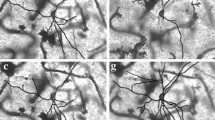Summary
The organization of the cortico-caudate projection neurones in the cerebral cortex was demonstrated by utilizing retrograde axonal transport of horseradish peroxidase (HRP) in the cat. Following injection of HRP into the head portion of the caudate nucleus, cortical labelled cells with HRP could be divided into two groups, consisting of smaller and larger pyramidal neurones. The location of the smaller neurones in the cortex was mainly in layer III, while that of the larger neurones was exclusively in layer V. In the cerebral cortex ipsilateral to the HRP-injected side, labelled cells belonging to the smaller group were distributed mostly in area 6 and occasionally in areas 4 and 5. Labelled cells belonging to the larger group were located exclusively in area 6. In the contralateral cortex, labelled cells were all smaller in size and distributed only in area 6. Referring to recent physiological as well as anatomical data, the smaller, labelled pyramidal cells were considered to be the proper, direct cortico-caudate neurones. The larger, labelled pyramidal cells were regarded as cortico-caudate projection neurones also sending axons to the lower brains tern and/or the spinal cord. The results of the present study indicate the existence of a close relationship between area 6 (premotor area) of the cerebral cortex and the caudate nucleus.
Similar content being viewed by others
References
Berrevoets CD, Kuypers HGJM (1975) Pericruciate cortical neurons projecting to the brain stem reticular formation, dorsal column nuclei and spinal cord in the cat. Neurosci Lett 1: 257–262
Blake DJ, Zarzecki P, Somjen GG (1976) Electrophyiological study of cortico-caudate projections in cats. J Neurobiol 7: 143–156
Groos WP, Ewing LK, Carter CM, Coulter JD (1978) Organization of corticospinal neurons in the cat. Brain Res 143: 393–419
De Olmos J, Heimer L (1977) Mapping of collateral projections with HPR method. Neurosci Lett 6: 107–114
Fox CA, Hillman DE, Siegesmund KA, Sether LA (1966) The primate globus pallidus and its feline and avian homologues. A Golgi and electron microscopic study. In: Hassler R, Stephan H (eds) Evolution of the forebrain. Thieme, Stuttgart, pp 237–248
Goldman PS, Nauta WJH (1977) An intricately patterned prefronto-caudate projection in the rhesus monkey. J Comp Neurol 171: 369–386
Hassler R, Muhs-Clement K (1964) Architektonischer Aufbau des sensorimotorischen und parietalen Cortex der Katze. J Hirnforsch 6: 377–420
Jinnai K, Matsuda Y (1979) Neurons of the motor cortex projecting commonly on the caudate nucleus and the lower brain stem in the cat. Neurosci Lett 13: 121–126
Jones EG, Coulter JD, Burton H, Porter R (1977) Cells of origin and terminal distribution of corticostriatal fibres arising in the sensory-motor cortex of monkey. J Comp Neurol 173: 53–80
Kemp JM, Powell TPS (1970) The cortico-striate projection in the monkey. Brain 93: 525–546
Kitai ST, Kocsis JD, Wood J (1976) Origin and characteristics of the cortico-caudate afferents: an anatomical and electrophysiological study. Brain Res 118: 137–141
Künzle H (1975) Bilateral projections from the precentral motor cortex to the putamen and other parts of the basal ganglia. An autoradiographic study in Macaca fascicularis. Brain Res 88: 195–210
Künzle H (1978) An autoradiographic analysis of the efferent connections from premotor and adjacent prefrontal regions (areas 6 and 9) in Macaca fascicularis. Brain Behav Evol 15: 185–234
Naito H, Nakamura K, Kurosaki T, Tamura Y (1969) Precise location of fast and slow pyramidal tract cells in cat sensorimotor cortex. Brain Res 14: 237–239
Nauta HJM, Pritz MB, Lasek RJ (1974) Afferents to the rat caudoputamen studied with horseradish peroxidase. An evaluation of a retrograde neuroanatomical research method. Brain Res 67: 219–238
Oka H, Jinnai K (1978) Common projection of the motor cortex to the caudate nucleus and the cerebellum. Exp Brain Res 31: 31–42
Royce GJ (1978) Cells of origin of subcortical afferents to the caudate nucleus: a horseradish peroxidase study in the cat. Brain Res 153: 465–475
Sato M, Itoh K, Mizuno N (1979) Distribution of thalamo-caudate neurons in the cat as demonstrated by horseradish peroxidase. Exp Brain Res 34: 143–153
Webster KE (1965) The cortico-striatal projection in the cat. J Anat 99: 329–337
Author information
Authors and Affiliations
Rights and permissions
About this article
Cite this article
Oka, H. Organization of the cortico-caudate projections. Exp Brain Res 40, 203–208 (1980). https://doi.org/10.1007/BF00237538
Received:
Published:
Issue Date:
DOI: https://doi.org/10.1007/BF00237538



